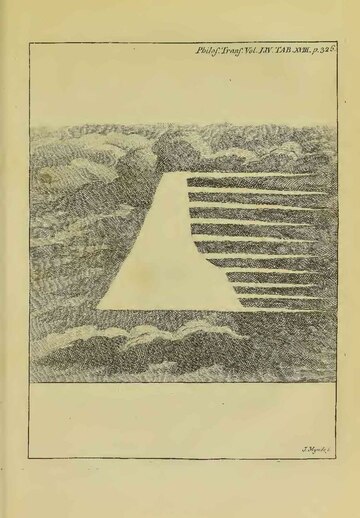Philosophical Transactions/Volume 54/An Account of a remarkable Meteor seen at Oxford, March 5, 1764
Good Sir,
Read Dec. 6,
1764.
zenith. It was much narrower at the vertex than the base, and consequently approached somewhat towards a pyramidal form. It remained a few minutes in a fixed and permanent state, after it had arrived at its greatest altitude, and was completely formed. About 11h 15′ P. M. it grew fainter, and much less vivid; and there then darted from it towards the W. several whitish rays and coruscations. At 11h 20′ the lucid column was barely visible, declining apparently southward, and soon after totally disappeared. I went to bed at 11h 30′ P. M. when the atmosphere was covered with the same kind of luminous vapour, that before the formation of the bright Colossean pillar had appeared; and, in the Southern part of the hemisphere, diversified by undulations of shining matter, that exhibited a most beautiful and agreeable scene.
It may not be improper here to remark, that a meteor, called an Aurora Borealis, was seen at Lisbon, according to [1] one of the public papers, the very same night. It is said to have lasted about four hours, and to have engaged the attention of the philosophers there. As from the similarity of certain circumstances it might have been denominated an Aurora Borealis, though appearing in the southern part of the heavens, as that I observed actually did; a more particular and distinct account of this phænomenon might possibly enable us to determine, with some degree of probability, whether or no it was the same with that by me here so imperfectly described. Could the identity of these meteors be clearly evinced, or indeed rendered probable, several curious corollaries, relative to the altitude, motion, velocity, &c. and even the very nature itself, of that I had so transient a view of, might perhaps be deducible from it.
Instances of Auroræ Australes, at least in our part of the world, are immensely rare. At present that observed by John Martyn, M. D. F. R. S. and Professor of Botany in the University of Cambridge, only occurs. The account of this very uncommon appearance, transmitted by that ingenious gentleman to the Royal Society, and published by them in the Philosophical Transactions [2], highly merits the attention of the curious meteorologist. This phænomenon, seen by him, January 23, 1749-50, and that of which I now send you so imperfect a description in several respects pretty well agreed; but in others, which it would be superfluous even to touch upon here, almost totally differed. Some of the [3] public papers informed us, that an extraordinary phænomenon was observed in the air at London, the preceding night, viz. March 4, 1764; which in a few particulars resembled that of which I have taken the liberty to communicate to you a short account in this letter, but in the rest those two meteors were dissimilar enough. Perhaps these Auroræ Australes may some time or other hereafter be more frequent than hitherto they have been, and by certain new circumstances attending them farther elucidate the theory of this species of meteors; the true cause of which, notwithstanding the labours and researches of several
learned men, seems not yet to be perfectly known. I am, with all possible consideration and esteem,
Christ-Church, Oxon.
Aug. 22, 1764.
- ↑ Lloyd's Evening Post.
- ↑ Philos. Transact. Vol. XLVI. p. 319.
- ↑ The St. James's Chronicle, &c. Nº 468.
